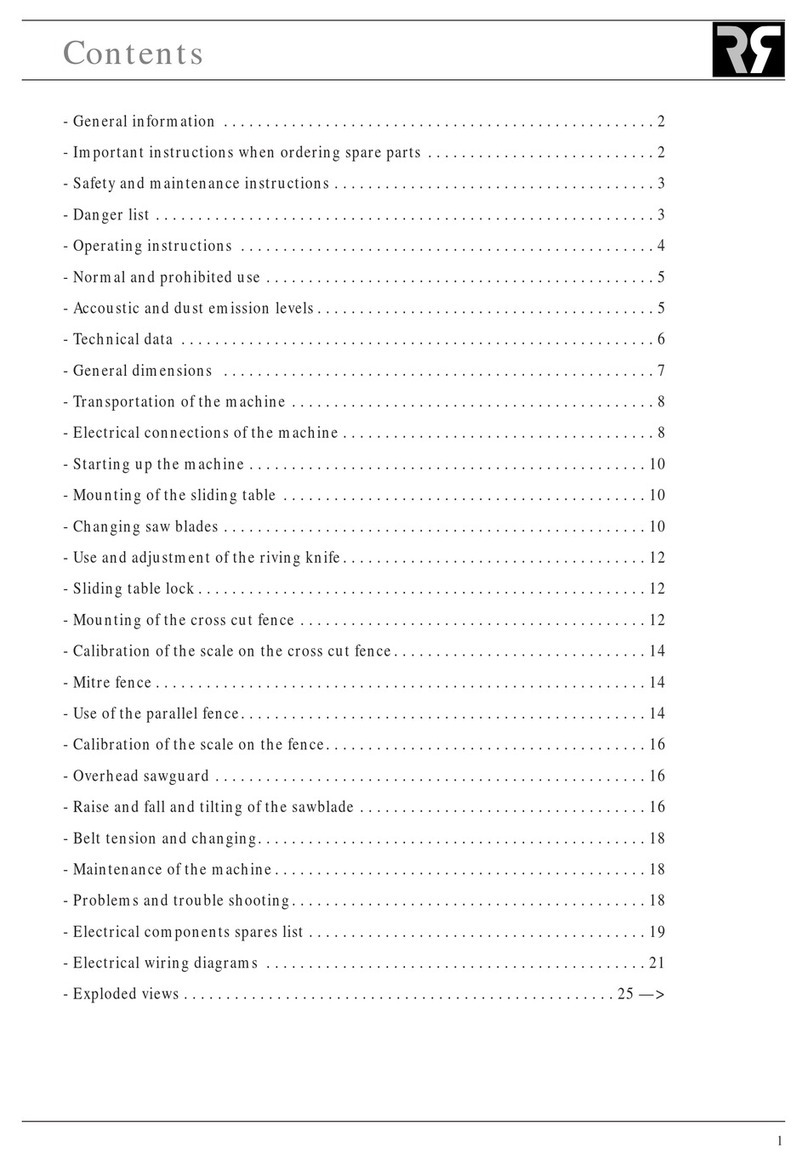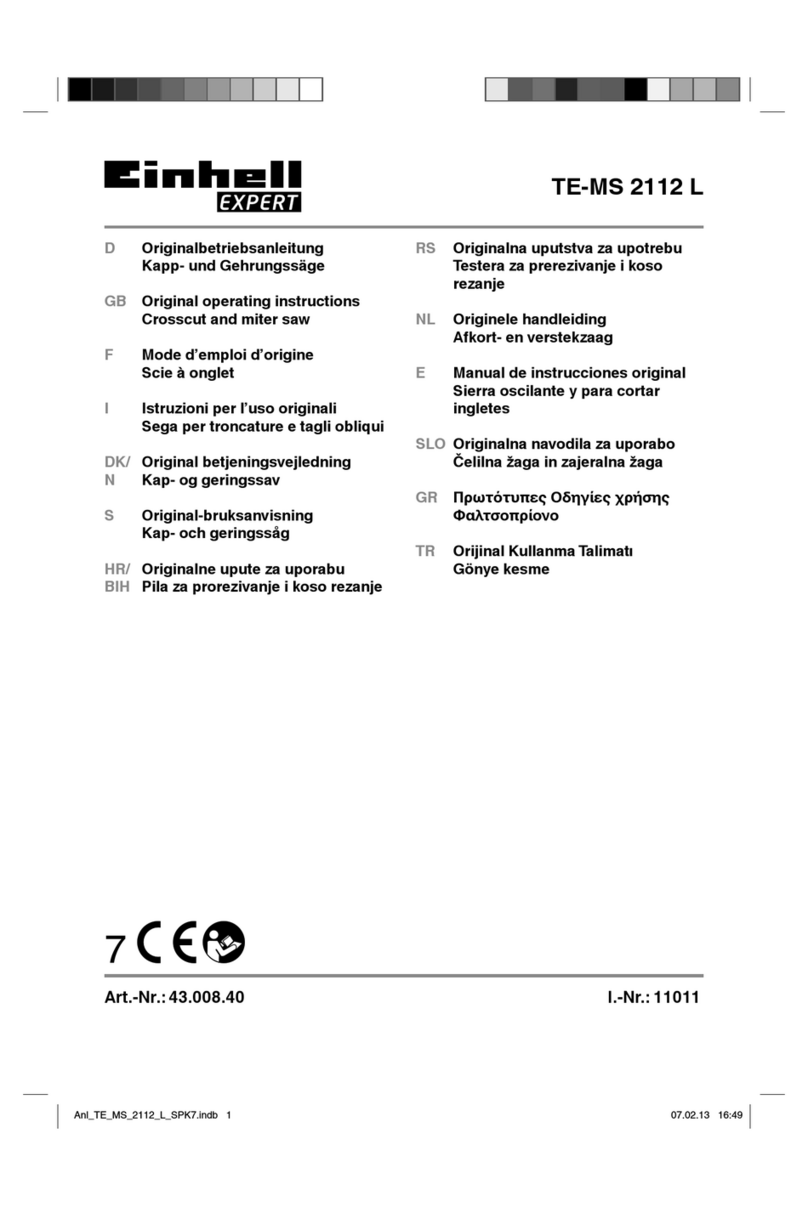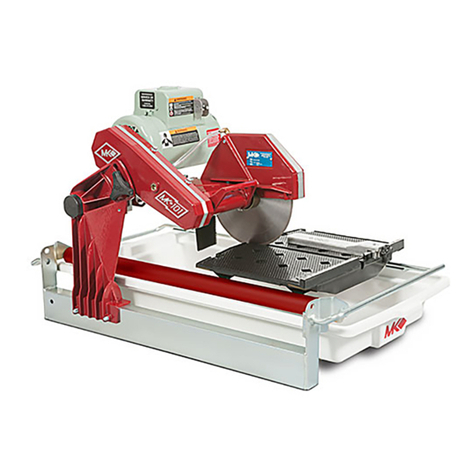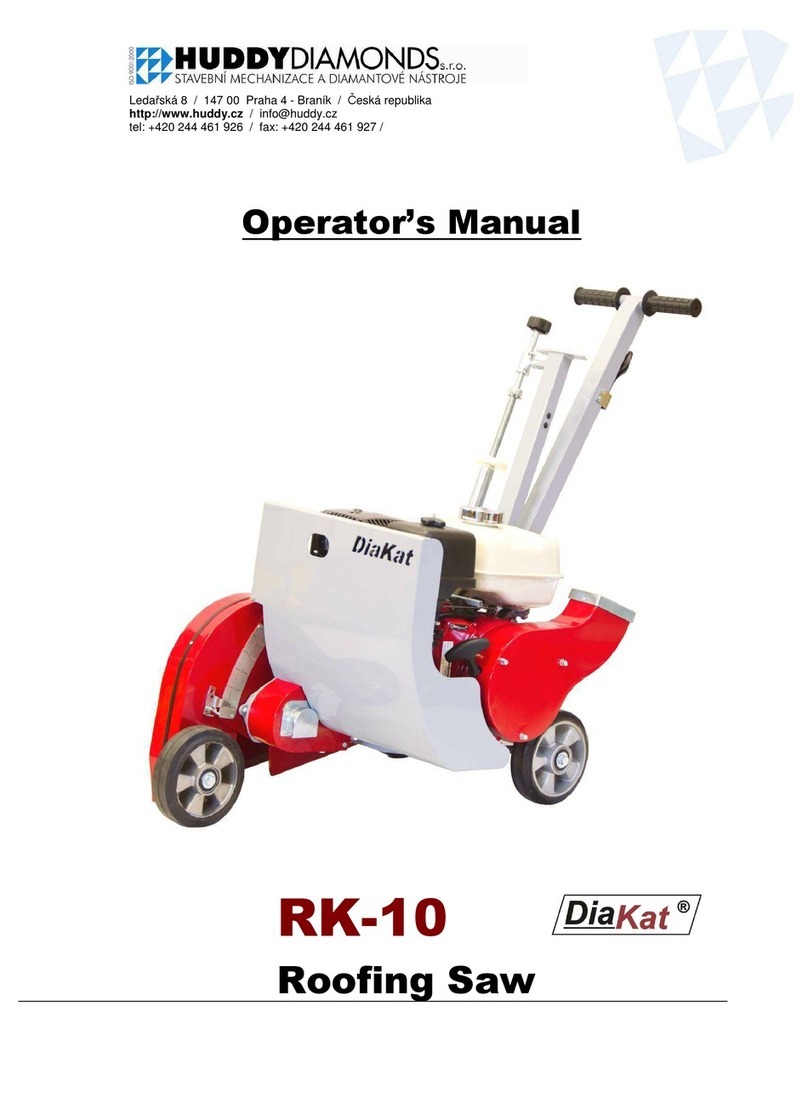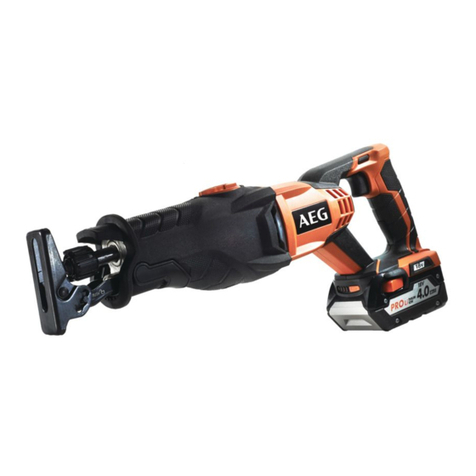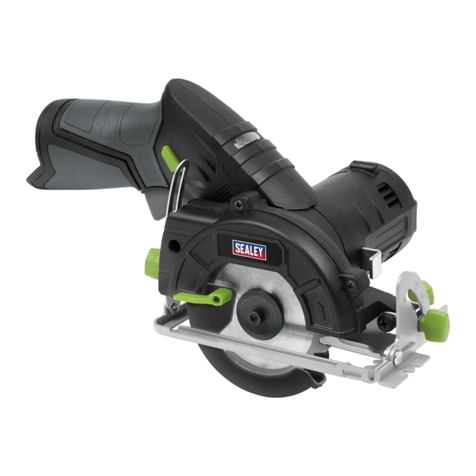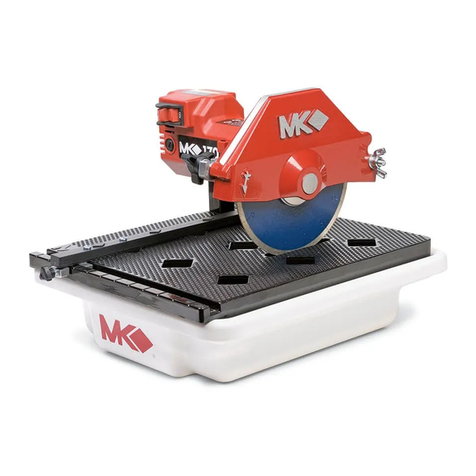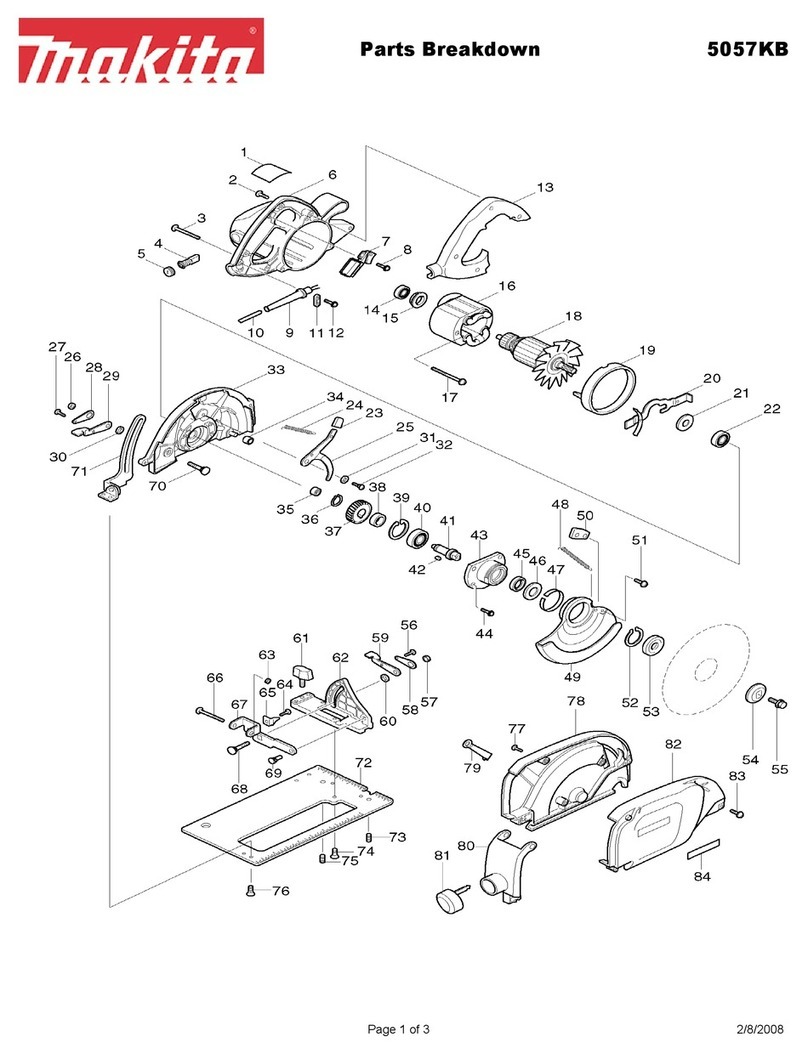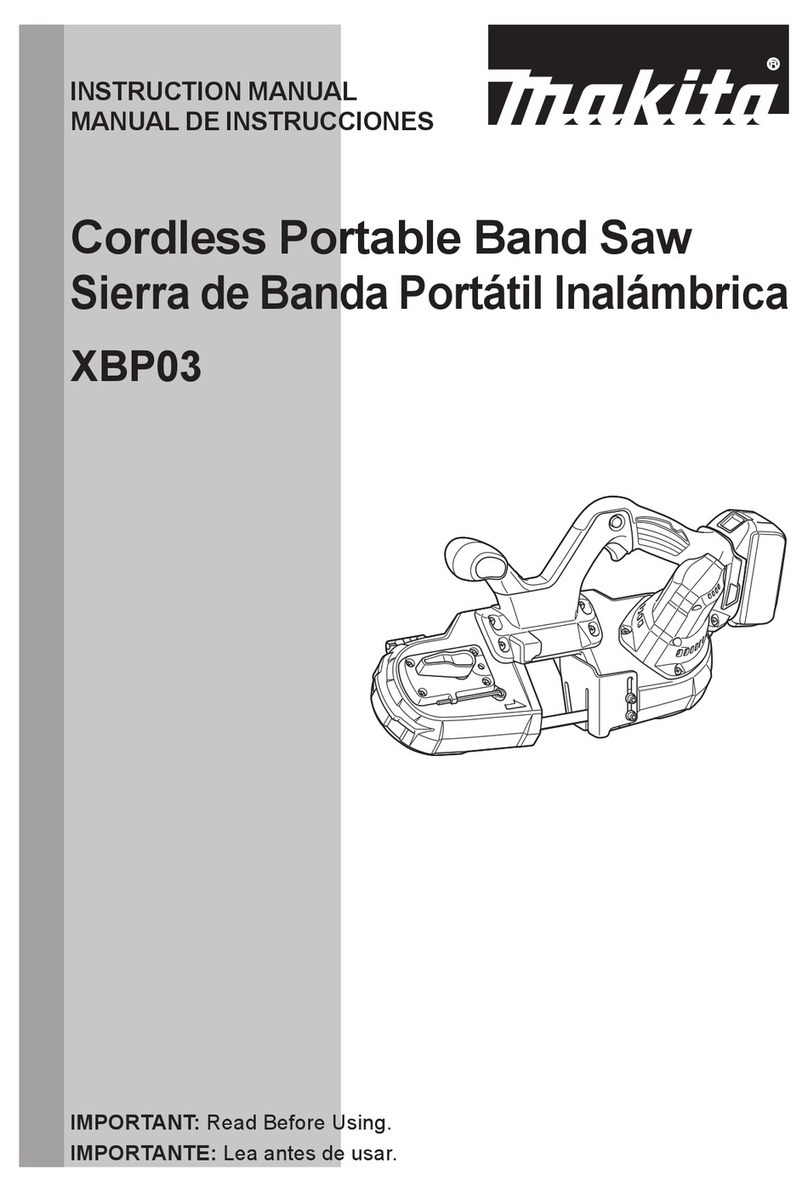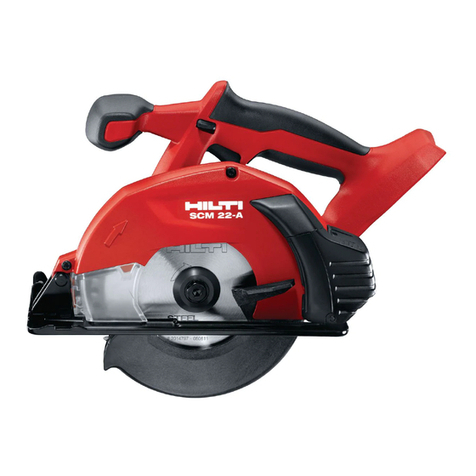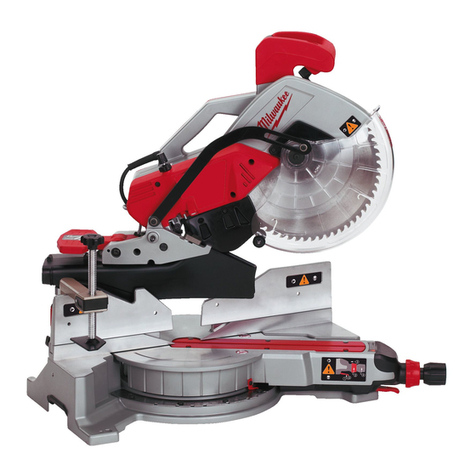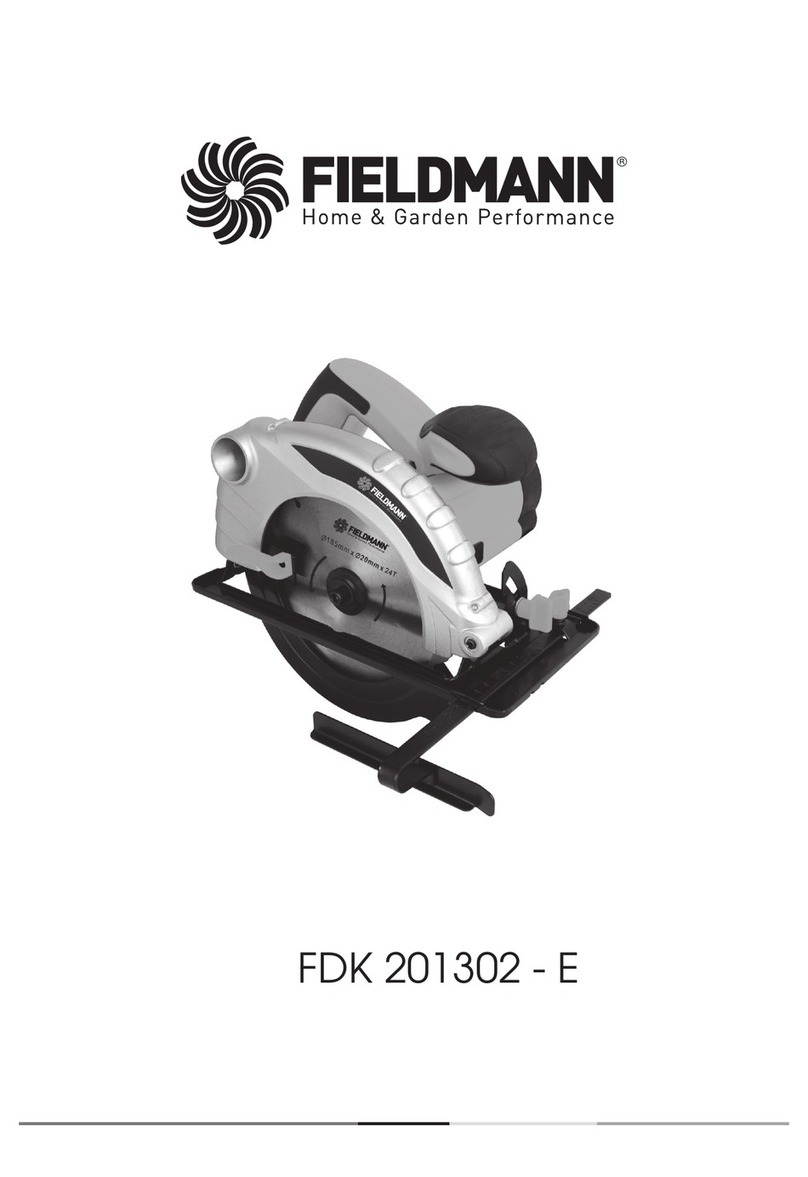Robland HX TZ User manual

HX SERIE
Manual
Betriebsanleitung

HX SERIES V0212 1
–English–Deutsch
Contents
General information 2
Safety and maintenance instructions 3
Danger list 3
Operating instructions 4
Explanation of acoustic levels 6
Normal use and prohibited use 7
Technical data 10
General dimensions 14
Transportation 15
Electrical connection 15
Mounting of the saw blade 17
Adjusting the riving knife 17
Saw hood 18
Tilting, rise and fall of the saw blade 18
Saw Guide 19
Sliding table 19
Mounting the cross cut table 18
Mounting the cross-cut fence 21
Use of the cross-cut fence 22
Drawing of the splinter protection 22
Mitre fence 23
Spindle 23
Tenoning guard and tenoning table 27
Thicknesser - planer - mortiser 28
Planer fence 29
Planer protection 29
Mortiser 31
Maintenance 33
Problems 35
Exploded views 70

2V0212 HX SERIES
–English –Deutsch
EG Conformiteitsverklaring - EG Konformitätserklärung
EC Declaration of Conformity - Déclaration de Conformité CE
Geachte Klant - Sehr Geehrter Kunde - Dear Customer - Cher Client,
Gelieve hieronder onze CE-homologatienummers te willen vinden voor onze houtbewerkingsmachines
Bitte finden Sie anbei unsere CE-Homologationsnummern für unsere Holzbearbeitungsmaschinen
Please find herewith our CE-homologation numbers for our woodworking machines
Nous prions de trouver ci-après nos numéros d'homologation CE nos machines pour le travail du bois
Wij, wir, we, nous
NV WERKHUIZEN LANDUYT
Kolvestraat 44
8000 BRUGGE - BELGIE
verklaren hierbij dat de bouwwijze van de machines - erklären dass die Bauart der Maschines - herewith declare that the
construction of the machines - certifions par la présente que la fabrication des machines
ROBLAND
voldoen aan de volgende richtlijnen / folgende Bestimmungen entsprichen / comply with the following relevant
regulations / sont conformes aux Normes suivantes:
Machine Directive 2006/42/CE - 2006/95/EC Low Voltage CE Directive
EMC Directive 2004/108/CE - EN 12100- Part 1 and Part 2 / EN 60204 Part 1 / EN 861
Type examination was carried out by the following approved body / Die Baumusterprüfung wurde von folgender Stelle
durchgeführt / Le modèle a été examiné par l'organisme suivant / Het typeonderzoek werd door volgende instelling
uitgevoerd:
AIB-Vinçotte International
Bollebergen 2/B
B-9052 Zwijnaarde
België
Nr. CE Serie
HX260(PRO) combinatiemachine / combinée à bois / Kombimaschine /combination machine 0101012011-2031122011
Nr. CE: Z10-174-142-A
HX310(PRO) combinatiemachine / combinée à bois / Kombimaschine /combination machine 0101012011-2031122011
Nr. CE: Z10-174-142-A
HX-TZ frees-zaag / toupie-scie / Fräse-Säge / spindle-saw 0101012011-2031122011
Nr. CE: Z10-174-142-A
XSD(B)310 vlak-vandiktebank / rabot-dégau / Abricht-Dickenhobel / planer-surfacer 0101012011-2031122011
Nr. CE: Z10-174-142-A
Brugge 15/03/2011 Yves Damman
Aftersales
tevens gemachtigd om technisch dossier samen te stellen
also authorized to establish the technical file
également authorisé d’établir le dossier technique
auch ermächtigt die technische Unterlagen zusammen zu stellen

HX SERIES V0212 3
–English–Deutsch
Safety and
maintenance instructions
Working wood with machines is a pleasant job that will give you a lot of satisfaction. Nevertheless,
working with a machine requires constant attention and care. Therefore, for your own safety, pay
attention to the instructions summarised in this chapter.
– The machine can only be used safely if the operator strictly follows the operating and safety
instructions.
– It is absolutely necessary to read this manual before using the machine in order to know how the
machine works and what its limitations are.
– Always make sure that all protections are mounted on the machine and that the machine is
connected to a dust extraction installation. Also provide sufficient space around the machine and
good lighting in the workshop.
– When changing the tools or when doing a maintenance job, the machine must always be
disconnected from its power supply.
– Knives and tools which are not correctly sharpened or are in bad condition not only diminish the
quality of the work provided, but also increase the risk of accidents.
– Always wear adapted clothing
– Keep children away from the machine and the workshop.
– To avoid hearing damage it is recommended to wear ear protection when working with the
– machine.
Danger list
This list was based on parts 1 and 2 of EN 292 and annexe A of part 2.

4V0212 HX SERIES
–English –Deutsch
Operating instructions
The following recommendations for safe working methods are given as examples, additional to the
information on the machine characteristics.
– When working with the spindle fence or the spindle, between 2 xed stops and when tenoning,
safety equipment must be used.
– Nevertheless, the user must also follow the operating instructions in order to avoid accidents.
1 Training of machine users.
It is absolutely necessary that the spindle-moulder user receives comprehensive training regarding
operating and adjusting the machine. In particular:
a) the risks involved in working with the machine;
b) the operating principles, the correct usage and adjustment of the machine;
c) the correct choice of the tools for each operation;
d) the safe handling of parts to be machined;
e) the position of the hands in relation to the cutter block;
2 Stability.
In order to be able to use the machine in a safe way, it’s necessary to place it in a stable position on
the ground or another stable surface.
3 Adjustment and installation.
a) Disconnect the machine from its power supply before every adjustment.
b) The recommendations of the manufacturer must be followed when adjusting an installing the
tools.
c) The tools must be suited to the material which has to be worked in order to assure a safe and
efficient usage. The tools must be correctly sharpened and installed with tool holders that are
carefully balanced.
4 Handling of tools.
In order to avoid severe cuts, safety measures must be taken when handling tools.
5 Installing tools
Special equipment, such as tool setting gauges, must be only used when the machine is not operating.
Table insert rings must be used in order to reduce to a minimum space between the table and the
spindle shaft.
6 Adjustment of the fences
a) Working with the spindle fence requires special attention:
b) A false or integrated fence should be used to minimise the opening between the tools and the
fences.
c) A push stick should be used as often as possible
d) A wood pusher should be used, together with protection, to push the piece manually
e) Long pieces need to be supported with roller supports.
7 Rotation direction and choice of speeds
It is very important that the chosen tool turns in the right direction. When the piece is presented, the
operator must take care that the work piece is fed in the correct direction and the correct speed has
been chosen. The speed must also be suited to the tool on the machine.

HX SERIES V0212 5
–English–Deutsch
8 Functioning of the machine, choice of safety equipment and adjustment
Because of the various tasks that can be carried out with the various types of spindle shafts, spindle
holders and cutter blocks, different types of safety equipment must be used. Every operation must be
examined separately and then the correct guarding must be chosen. The minimal opening in the table
also depends on the type of cutter block, diameter of the knives and height in which the cutter block is
adjusted. This can be done by using the able insert rings which are delivered with the machine. In that
way, the opening is as small as possible and the piece can no longer ip over and hit the knives.
Using a power feeder can prevent most serious accidents involving the hands. Such feeders can easily
be adjusted and adapted to the size of the pieces.
When no power feeder is used, the wood pushers must be used, the horizontal and vertical springs
making a tunnel in which the piece can be slid. This pusher, together with other safety equipment,
reduces the gap between the cutting tool and the guide fences.
9 Working with the spindle fence when the total length of the piece has to be machined
In most cases a straight guard fence is used. The pieces can therefore be guided in the angle made
by the table and the fence. The vertical and horizontal pushers can be placed in such way that they
make a tunnel in which the rst piece can be pushed. The second piece is then used to push the rst
one, the last piece is pushed forward with a wood pusher. Special blocks must be used relative to the
dimensions of the piece. When working panels of small thickness, only the top of the spring may be
used, on condition that the thickness matches.
On a spindle-moulder, the distance between the 2 extremities of the spindle guard fence must be large
enough to leave enough space for the cutter block. Thus the knives, the cutter block and the spindle
shaft may be exposed and extremity of the piece may come in contact with nose of the exit spindle
guard fence. There risks can be avoided by using a false fence between the 2 spindle guard fences
thus limiting the opening between them.
10 Working with the spindle fence when only a part of the piece is machined
When working with the spindle fence and this between 2 stops xed onto the machine table or fences,
only a part of the work piece is machined. By doing so, the cutting tool starts to machine the wood in
the full section of the wood and does not start at the front, where the cutting action is more gradual
and less severe. The cutting action is stopped before the work piece end is reached. This action is
very dangerous and needs special care and attention. A stop solidly xed at the front and back, must
be used (see the example further in this manual)! A piece may only be guided by hand when it is
sufficiently large, in all other cases a gauge or a support with protection must be used in order to avoid
serious accidents. By means of the gauge, the piece can be quickly and precisely be put into place
and rmly held there. A quick clamping system, working with tumblers or with cams, is most practical
system to hold the piece. When the front and backstops are xed to the spindle guard fence or to the
table, a better control of the gauge is possible.
11 Working with the ring guard
When working with the ring guard, a support must be used, except when a certain process does not
allow this, i.e. when the piece is too large to make the use of the support practical, or when the piece is
so small or so difficult to machine that it cannot be held in the support without danger. The nal shape
is obtained by holding the gauge against a guidance bearing which is xed to the spindle while the
piece is held against the tool. The gauge can be part of the support.
12 Chamfering
When chamfering a solid support or a tilt able adjustable spindle guard fence must be used. A wood
pusher must be used for the nal part of the machining.
13 Working in the same direction as the tools
It is extremely dangerous to work in the same direction as the tools, as the operator cannot exert force
to resist the strong movement of the piece as the tool comes into contact with it. Working in the same
direction as the tools as absolutely forbidden, even when a support is used.

6V0212 HX SERIES
–English –Deutsch
14 Other machining
For other types of work, e.g. tenoning, special gauges or supports can be used in order to avoid
accidents.
Use of safety accessories
The following safety accessories can be used to help the operator during his work:
– supports
– wood pushers
– power feeders
– rollers
– stops
15 Noise reduction
a) The condition of the tools is important to keep the noise level as low as possible.
b) The material and the position of the guards are important to reduce the noise level.
c) Using the correct speed will reduce the noise level.
d) What is mentioned above does not take away the fact that separate safety equipment must still
be used.
Explanation of acoustic levels
The values given are the output levels; there are not necessarily the levels on which the operator can
work safely. Although there is a link between the output values and the safe working levels, it cannot be
used in a reliable way to determine whether supplementary measures should be taken.
ACOUSTIC LEVELS
Measurements: as per ISO norm 7960
as per annexe D
Work station
und load
Level continuous
acoustic pressure as
per index A dB(A)
Level acoust.
power
dB(A) (MW)
Max. Value accoust.
pressure as per index
C (instantaneous)
dB
Sawing 88 103 (19,9) < 130
Moulding 84 97 (3,2) < 130
Tenoning 86 97 (5) < 130
Planing 92 98 (6,3) < 130
Thicknessing 83 97 (5) < 130
Mortising 96 107 (250,1) < 130

HX SERIES V0212 7
–English–Deutsch
Normal use and
prohibited use
CIRCULAR SAW
The table saw assembly is designed for the following working processes and equipped with protective
devices. It is not designed to work materials such as ferrous or non-ferrous materials, and therefore
tasks that differ from the ones stated below are prohibited.
– Ripping with the parallel saw fence with/without tilted saw blade with the fence upright or in the low
position.
– Right-angled or mitre cuts with the 90° fence mounted to the sliding table with tilted or vertical saw
blade.
– Cross cutting work pieces with the adjustable stop on the 90° fence.
– Cutting panels or solid wood on the sliding table.
PROHIBITED USE
Following tasks are prohibited on the table saw:
– submerged cuts by removing the riving knife and/or guard;
– all types of cuts without using the table saw fence, the 90° fence or sliding table;
– cutting large work pieces that exceed the table capacity without using aids such as roll supports.
REMAINING RISKS
Main risks on a table saw are:
– unintentional contact of the hands with the running saw blade;
– work piece kickback;
– tipping of the work piece due to insufficient support.
MOULDER-SHAPER
The sharper assembly is designed for the following tasks and equipped with protective devices. Other
tasks than listed below are therefore prohibited.
– mould and form straight and curved pieces on the vertical spindle;
– shaping of curved work pieces using a ring guard fence;
– mortising, tenoning and panel edge shaping using corresponding safety devices.
PROHIBITED USE
The following tasks are prohibited on the moulder-shaper unit:
– down-cut shaping, i.e. when feed and tool rotation direction is the same;
– slotting with saw blades;
– using tool diameters which are not adapted to the spindle by using reducing sleeves;
– using larger tool diameters and higher speeds than the shown in the diameter-speed diagram;
– the use of ferrous and non-ferrous materials.
REMAINING RISKS
Spindle shapers are one the main causes of injuries in woodworking. Nearly all accidents result in
hand injuries. They are due to contact with the rotating tool when the work piece is fed by hand and
kickback occurs to sudden forward movement of the work piece.
The main danger areas on the shaper-moulder are:
– the working area;
– the moving machine and tool parts;
– the kickback area.

8V0212 HX SERIES
–English –Deutsch
Always use appropriate protection devices and always observe the specic regulations for accident
prevention.
Despite the use of specic protection devices and the application of the hygiene and safety
instructions, some risks remain when working with the moulder-shaper:
– Risk of accidents in the insecure area of the tools
– Risk of wounding while replacing tools
– Risk of wounding by the piece of wood itself, or by wood shavings
– Crushing of the ngers
– Risk of jamming of the hand in the machine, when using a removable pusher
– Risk of back kicked pieces of wood
– Health risks through prolonged inhalation of particles, especially oak, beech or other exotic sorts of
wood
– Deafness through prolonged exposition to noise
PLANER-THICKNESSER
The planer-thicknesser is designed for the following processes, and is equipped with protection devices
and can only be used to work wood. All working processes that do not comply with these instructions
are therefore prohibited.
– Planing the wide surface of the work pieces on the planer unit;
– Planing the narrow side of the work piece on the planer unit;
– Bevelling an edge on work pieces on the planer unit;
PROHIBITED USE
The following tasks are prohibited on the planer-thicknesser unit:
– down cut planing i.e. when the feeding direction and the planer’s arbour rotation and direction are
the same and the outfeed planer table is set lower than the infeed table;
– insertion cuts on the planer unit i.e. when the work piece is not worked along its entire length;
REMAINING RISKS
The most common danger areas on the planer-thicknesser unit are:
– the working area;
– the rotating tool, e.g. contact with the blades, getting caught in the rotating planer arbor, ejection of
work parts, knots, etc;
– the work piece kickback area.
Despite the use of specic protection devices and the application of the hygiene and safety
instructions, some risks remain when working with the planer-thicknesser:
– Risk of accidents in the insecure area of the tools
– Risk of wounding while replacing tools
– Risk of wounding by the piece of wood itself, or by wood shavings
– Crushing of the ngers
– Risk of jamming of the hand in the machine, when using a removable pusher
– Risk of backkicking
– Health risks through prolonged inhalation of particles, especially oak, beech or other exotic sorts of
wood
– Deafness through prolonged exposition to noise

HX SERIES V0212 9
–English–Deutsch
MORTISER
The mortiser unit is composed of the removable support and the chuck mounted on the planer arbor. It
is designed to work wood; the use of all other materials is prohibited.
– mortising holes in all wood types with or without depth stop;
– mortising slots in solid wood;
– boring out knot holes
PROHIBITED USE
The following tasks are prohibited on the mortising unit;
– milling or tenoning with tools that do not have this purpose
– grinding metal parts e.g. planer knives.
REMAINGING RISKS
The main sources of danger on a mortiser unit are:
– unintentional contact of hands or other parts of the body with the rotating tool;
– tipping of the work piece due to insufficient support;
– contact with the planer arbor as it rotates.
Despite the use of specic protection devices and the application of the hygiene and safety
instructions, some risks remain when working with the mortiser:
– Risk of accidents in the insecure area of the tools
– Risk of wounding while replacing tools (cuts through contact with the knives)
– Crushing of the ngers
– Risk of jamming of the hand in the machine, when using a removable pusher
– Risk of back kicked pieces of wood
– Health risks through prolonged inhalation of particles, especially oak, beech or other exotic sorts of
wood
– Deafness through prolonged exposition to noise
TYPES OF TOOLS
Cutter blocks and the tool holders with interchangeable knives are frequently used when moulding.
The cutter blocks can be made in 1 piece, the cutting part being tted in a body of hard steel, mostly
chromium steel. The tool holders consist of the part on which the knives are tted mechanically. Their
cutting part is made out of hard metal (HSS) or calcium-carbide (K), as is the case for the cutter blocks.
Circular saw
The use of saw blades in hard metal (HSS) is strictly forbidden. Always use carbide-tipped (K) saw
blades.
Planer-thicknesser
The most frequently used planer knives are carbide (K) or hard metal blades (HSS).
Mortiser
Only use “left” drills on the mortiser. To avoid vibrations short drills should be used as often as possible.
IMPORTANT:
for each tool and for each diameter, the correct speed must be chosen.

10 V0212 HX SERIES
–English –Deutsch
Technical data HX TZ
Weight (net) 340 kg
Tension 230 V Mono / 400 V Drehstrom - 3phase
Saw
R.p.m. 4500
Diameter saw blade and bore 250 x 30 mm
Cutting depth at 90° 85 mm
Cutting depth at 45° 55 mm
Dimensions cast iron table 1077 x 273 mm
Length sliding table 1250 mm
Cutting length 1400 mm
Width sliding table 320 mm
Cutting width parallel fence 600 mm
Motor power 3 hp/PS
Spindle
R.p.m. machine 400 V 3000/6000
R.p.m. machine 230 V (single phase) 6000
Diameter spindle arbor 30 mm (option 50 mm)
Capacity spindle arbor 120 mm
Travel 140 mm
Dimensions table opening 180 mm
Motor power 3 hp/PS

HX SERIES V0212 11
–English–Deutsch
Technical data HX260
Weight (net) 485 kg
Tension 230 V Mono / 400 V driefasig - triphasé
Saw
R.p.m. 4500
Diameter saw blade and bore 250 x 30 mm
Cutting depth at 90° 85 mm
Cutting depth at 45° 55 mm
Dimensions cast iron table 1077 x 273 mm
Length sliding table 1250 mm (optie-option 1450)
Cutting length 900 mm (optie-option 1250)
Width sliding table 320 mm
Cutting width parallel fence 600 mm
Motor power 3 pk/cv
Spindle
R.p.m. machine 400 V 3000/6000
R.p.m. machine 230 V (single phase) 6000
Diameter spindle arbor 30 mm (optie-option 50 mm)
Capacity spindle arbor 122 mm
Travel 140 mm
Dimensions table opening 180 mm
Motor power 3 pk/cv
Planer-Thicknesser
Total length planer tables 1320 mm
Capacity thicknesser 230 mm
Diameter cutter block 70 mm
Knives 3
Dimensions knives 260 x 25 x 3 mm
Feeding speed 6 m/min
R.p.m. 5500
Motor power 3 pk/cv
Morticer (option)
Chuck 0 - 16 mm
Travel 165 x 140 x 85 mm

12 V0212 HX SERIES
–English –Deutsch
Technical data HX310
Voltage V 230/400 – 230 Single phase
Weight kg 400
Packing (L x W x H) mm 1160 x 1600 x 1000
Motors three phase 230-400 V kW 2.2 (3 hp)
Motors single phase kW 2,2 (3 hp)
Planer-Thicknesser
Spindle diameter mm 70
Knives 3
Dimension of knives mm 310 x 25 x 3
R.P.M. T/min 5500
Width mm 310
Max. chip removal mm 4
Planer table length mm 1320
Material planer table cast iron
Width planer table mm 310
Capacity planer mm 230
Feed speed m/min 6
Material planer cast iron
Saw
Max. diameter saw blade mm 250
Max. depth of cut with saw blade 250 mm mm 85
Type saw blade Carbide (K)
Diameter spindle mm 30
Tilt ° 45
R.P.M. spindle 4500
Dimensions saw tables mm 1070 x 273
Material saw table cast iron
Spindle
Diameter mm 30
Rise and fall mm 140
Useful length spindle mm 125
Diameter table opening mm 180
Max. diameter tool in the spindle fence mm 180
Max. diameter tool in the tenoning hood mm 250
R.P.M. spindle three phase 3000/6000
R.P.M. spindle single phase 6000
Dimensions spindle table mm 1070 x 273
Material spindle table cast iron
Material spindle fence guide plates aluminium
Mortiser (option)
R.P.M. mortiser T/min 5400
Type of mortiser 2 jaws
Mounting the mortiser left hand thread M24x1,5 mm
Capacity mortiser mm 0-16
Type of tools left hand drills
Dimensions mortising unit mm 425x200
Travel length mm 165
Travel in and out mm 140
Travel height mm 85
Material mortising table cast iron
Diameter dust suction outlet for all tools mm 100 diameter

HX SERIES V0212 13
–English–Deutsch
Technical data HX310 PRO
Weight (net) 539 kg
Tension 230 V Mono / 400 V Drehstrom - 3phase
Saw
R.p.m. 4500
Diameter saw blade and bore 250 x 30 mm
Cutting depth at 90° 85 mm
Cutting depth at 45° 55 mm
Dimensions cast iron table 1077 x 273 mm
Length sliding table 1250 mm
Cutting length 1400 mm
Width sliding table 320 mm
Cutting width parallel fence 600 mm
Motor power 4 PS/hp
Spindle
R.p.m. machine 400 V 3000/6000
R.p.m. machine 230 V (single phase) 6000
Diameter spindle arbor 30 mm (option 50 mm)
Capacity spindle arbor 120 mm
Travel 140 mm
Dimensions table opening 180 mm
Motor power 4 PS/hp
Planer-Thicknesser
Total length planer tables 1320 mm
Capacity thicknesser 230 mm
Diameter cutter block 70 mm
Knives 3
Dimensions knives 310 x 25 x 3 mm
Feeding speed 6 m/min
R.p.m. 5500
Motor power 4 PS/hp
Morticer (option)
Chuck 0 - 16 mm
Travel 165 x 140 x 85 mm

14 V0212 HX SERIES
–English –Deutsch
General dimensions
Power supply 2,2 kW three phase
2.2 kW single phase
Overload trip setting 5 A three phase 400 V 2,2 kW
8,5 A three phase 230 V 2,2 kW
15 A single phase 230 V 2,2 kW
15 A mono
Power supply cable section 2,5 mm² min.
Frequency 50 Hz

HX SERIES V0212 15
–English–Deutsch
Transportation (g. 1, 2 en 3)
Depending on the method of transport or shipping, you will receive the machine in a case or on
transport blocks. The packing itself, made of bre plates, and the wooden beams can easily be
recycled. Take the sides of the crates and remove the carton and the other parts fastened to the bottom
of the crate. Take the machine of the pallet by means of lever bands.
Self pick-up: for self pick-up, the assembled machine is securely mounted on transport blocks.
The table surfaces and all exposed parts are covered with a protective plastic lm.
Avoid any impact when unloading the machine and never pull on the worktables or aluminium sliding
table.
Machine on pallet: move the machine on level ground using a pallet jack as shown in the drawing.
Use a wooden ramp made of thick board and wooden beams, and secure the ramp to the pallet in
order to avoid slipping of the ramp.
Never try to move the machine on rollers when its on an incline.
Once the machine is on level ground, move it with a pallet jack, or forklift.
Fig. 1, 2, 3
ATTENTION:
Always make sure that the useful loading capacity is big enough. Place the lever bands in such a way
that they don’t put too much pressure on the tables. Lift the machine a few centimetres to remove the
bottom of the crate.
Start-up:
Always make sure the machine wasn’t damaged during transport or whilst unloading. Place the
machine stable on a solid underground and make sure that there is enough space around the machine
to use it safely.
ATTENTION:
Working with woodworking machines in an unsafe way can be very dangerous. It is in your own
interest that you use all safety devices and protections.
Electrical connection (g. 4, 5 en 6)
The electrical connection must be carried out by a qualied electrician who is able to calculate exactly
the required wire section and amperage of the fuses.
– check that the main voltage of your machine corresponds with the voltage in your workshop;
– then open the electrical connection box at the back of the machine (g. 4);
– connect the 3 phases to the terminals marked L1, L2, L3 (g.5);
– if there is a neutral conductor (blue), it is connected to the terminal N;
– connect the earth (green + yellow) to the terminal marked with the earth symbol;
– check if the spindle runs freely before starting up the machine;
– check the rotation direction of the motors. This test can only be done on the motor of the spindle
at 3000 R.P.M. The rotation direction of the motor has to be, seen from above, anticlockwise. If

16 V0212 HX SERIES
–English –Deutsch
the rotation direction of the spindle is not correct, the wires L1 and L2 must be exchanged. If this
direction is correct, all other motors have the right rotation direction.
Fig.4 Fig.5
Warning:
The rotation direction can never be tested on the saw motor. The saw spindle has a left screw
thread so that the saw blade can loosen if the rotation direction is incorrect.
Observation:
1 When starting a single phase machine, the start button has to be turned until the machine runs
at full speed. As long as the start button is turned, the starting capacitor of the machine stays
connected and will get damaged.
2 The motors are secured against overloading. If the motor is turned off because of this protection,
you need to wait until the machine has cooled down, before starting it up again.
3 When starting a three phase machine, simply push the green start button.
Fig.6
1 Single phase starter switch
2 Start button
3 Stop button
4 Selector switch
5 Emergency stop button
6 Warning bulb brake release

HX SERIES V0212 17
–English–Deutsch
Mounting of the saw blade (g.7)
1 Slide away the table.
2 Open the lower saw blade cover plate (1).
3 Raise the saw blade to the highest point.
4 Now put the locating pin (3) in the saw table to block the saw arbor.
5 Tighten the saw nut with the hookspanner (4). Warning: left hand threaded saw arbor!
6 Do not forget to remove the pin which holds the saw arbor in place while tightening the nut.
Fig.7
Adjusting the riving knife (g. 8)
The saw is equipped with a riving knife suitable for saw blade diameters of 200 and 250 mm.
Always set the riving knife (1) close to the saw blade so that the gap never exceeds 4 mm. The riving
knife can be set in line with the saw blade by using the bolt (1) and the 3 adjustment screws (2). The
bolt only moves the riving knife longitudinally. The 3 adjustment screws (2) the riving aligns with the
saw blade.
Fig.8
the bolt
adjustment screws

18 V0212 HX SERIES
–English –Deutsch
Saw hood (g. 9)
The saw hood, delivered with the machine, is adjusted to the saw blades with a diameter of 200 mm
and 250 mm or 315 mm and can be mounted without extra tools. Using the handle (1), the saw cap
can be locked in any position.
Fig.9
Tilting, rise and fall of the saw blade
(g. 9 bis)
1 The handle (1) can be loosened by turning it ½ turn to the left. Then the saw blade can be raised
or lowered either by pushing the handle down or pulling it up. To lock the height, turn the handle
to the right (clockwise).
2 After loosening the locking handle (3), the saw blade can be tilted from 90° to 45° by turning the
cranck handle (2) After setting the saw blade, always lock the handle.
Fig.9 bis
1 2
3
1

HX SERIES V0212 19
–English–Deutsch
Saw guide (g. 10)
1 The saw guide is mounted on the cross-cut fence by means of 2 quick release handles (3).
2 This saw guide can be moved along the scale bar and can be secured by pushing the locking
handle (2) down.
3 The saw guide has T-grooves on 2 sides, which allows a high or low position.
4 Adjust the height of the saw blade, in accordance with the thickness of the piece.
5 If possible, mount the guide, according to the height of the piece, vertically or horizontally and
pull it back to the height of the riving knife.
6 Lock the guide with the handles (3)
7 The wanted cut can be read of the scale bar
8 For small cuts and cuts with tilted saw blade, the saw guide can be tilted to the low position thus
avoiding sawing the saw guide, when making thin cuts.
WARNING:
for narrow cuts along the saw fence always use a push stick!
Fig.10
Sliding table (g. 11)
The machine is delivered with the sliding table mounted onto it. For a good adjustment and functioning
of the sliding table, it is necessary that the machine is evenly placed in both directions by means of a
level. All adjustments and adaptations of the sliding table have been made by the factory.
To create a smooth movement of the wood or the panel, the sliding table is set at +/- 0.2 mm above de
cast iron saw table.
The sliding table can be locked in one position along the whole length. This is necessary when, for
example, sawing lengthways with the parallel fence.
The bolt is situated on the side of the sliding table (g. 11.1). Pull the bolt forward and click it in the
opening at the side of the sliding table. To unlock it, pull the bolt backwards and turn it 180°. Two
rubber stops on the lower beam of the sliding table stop the course of the sliding table. When multiple
movements back and forwards are repeated, it is possible that the ball bearing moves slightly. This will
cause some resistance when pushing the sliding table.
This can also occur if the total course of the sliding table is shortened. With a few short pushes, with
the purpose of reaching the end of the course, the position of the ball bearing can be improved.
1
2
This manual suits for next models
3
Table of contents
Languages:
Other Robland Saw manuals
